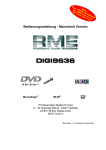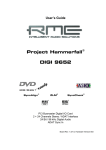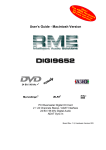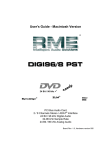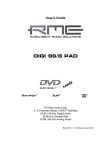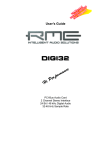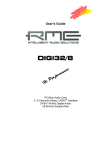Download RME Audio DIGI96/8 PST User`s guide
Transcript
User's Guide Analog Expansion Board for DIGI96/8 Series and Hammerfall Serie 4/8 Channels, 24 Bit Contents 1 2 3 4 5 6 7 8 9 10 11 Introduction ..................................................................3 Package Contents .......................................................3 Hardware Requirements..............................................3 Technical Specifications ..............................................3 Hardware Installation ...................................................4 Alternative Installation..................................................5 Operation and Usage...................................................6 Channel Routing AEB4-O............................................6 Pin assignment of the TRS jacks ................................7 Warranty ......................................................................7 Appendix......................................................................7 User's Guide AEB4/8-O 2 1. Introduction Thank you for choosing the RME AEB technology. The Analog Expansion Boards add 4 or 8 analog outputs in professional quality to RME's digital audio cards. Level adjustment +4 dBu/-10 dBV, 107 dBA SNR and highest suppression of PC-noise guarantee perfect sound quality. 2. Package Contents Please ensure that all the following parts are included in the AEB's packaging box: • • • • • • Analog Expansion Board 1 Clock cable 3-core 1 Data cable 2-core 1 Cable adapter 5 ¼" to 2 x 3,5" 1 Set of nuts Manual, drill template 3. Hardware Requirements AEBs can only be used with RME cards. DIGI96 Series AEBs use the internal ADAT interface of the DIGI cards. Therefore they do not work with the DIGI96 (which did not support ADAT). One AEBx-I and one AEBx-O can be connected and operated simultaneously, in all possible combinations. Hammerfall Series An operation with the Hammerfall or Hammerfall Light requires board revision 1.5 or higher, because the internal connectors ADAT1Out and ADAT2Out were not implemented in earlier versions. One AEBx-I and two AEBx-O can be connected and operated simultaneously, in all possible combinations. 4. Technical Specifications • • • • • • • • • • • • Output AEB4-O: 4 x 1/4" TRS jack, servo balanced Output AEB8-I: 4 x 1/4" TRS jack, unbalanced Dynamic ratio: 103 dB (RMS unweighted), 106 dBA THD+N: -95 dB (0.0017 %) Frequency response -0.1 dB: 10 Hz - 21 kHz Output level for 0 dBFS @ +4 dBu: +12 dBu Output level for 0 dBFS @ -10 dBV: +2 dBV Crosstalk: > 110 dB Supported sample rates: 44.1 kHz, 48 kHz Output impedance: 75 Ohm Power supply uses 3.5" floppy connector, 12 V/5 V DC, 190 mA Standard bracket, board dimensions AEB4: 85 x 95 mm, AEB8: 120 x 95 mm User's Guide AEB4/8-O 3 5. Hardware Installation Important: Switch off the computer and remove the power cable from the power supply before fitting the AEB. 1. Disconnect the power cable and all other cables from the computer. 2. Remove the PC housing; further information on how to do this can be obtained from your computer´s instruction manual. 3. Neutralize the static build up by touching the PC metal-chassis before unpacking the AEB from the protective bag. 4. Connect the AEB's DIG IN and the DIGI's Sync-Out (Hammerfall: ADAT1/2 Out) using the supplied 2-wire cable. Watch out for correct polarity: The shield wire is black, and must be connected to the pin marked GND on the DIGI (the right one). 5. Connect power supply: The AEB uses a floppy power connector (3,5"). In case no such connector is available use the supplied adapter cable to connect the AEB to any free 5 ¼" power connector. 6. Insert the AEB into a free slot, press and fasten the screw. The AEB needs no slot on the motherboard, but includes a stabilizing edge, which fits in both PCI and ISA slots. 7. Re-insert the DIGI in a PCI slot and fasten the screw. 8. Re-place the PC housing and tighten the screws. 9. Re-connect the power cable and all other cables/connections. Connecting an AEBx-O to a DIGI96/8 PAD User's Guide AEB4/8-O 4 Connecting an AEBx-O to a Hammerfall 6. Alternative Installation Installation is done comfortably as described using the attached bracket. Alternatively it is possible to mount the AEB at a different place inside the computer using the supplied nuts. This requires to drill 4 holes into the housing. RME does not accept claims for damages of any kind when installing the AEB in this way! Modifications to the housing should be done by qualified technicians only, and only after having removed all components from the housing (danger of short circuit by metal splinter etc). 1. Remove the bracket from the AEB (2 screws). 2. Carefully check that the desired location offers a flat plane, is free from any voltage carrying devices or cables, and that the AEB does not get in contact with other devices even when the housing is closed. 3. Please note that the lenght of the supplied cables does not allow any distance to the DIGI card. 4. Drill 4 holes, diameter 0.5" (13 mm), distance of 0.75" (19.05 mm) each, at the desired place (see drill template). 5. Fit the AEB into the holes and fix it with the supplied nuts. User's Guide AEB4/8-O 5 7. Operation and Usage The AEB works like any other device having an ADAT input, but is located inside your computer. Please note that the AEB requires the DIGI96/8 to send the output format 'ADAT'. Therefore using the DIGI96/8 series 'Force ADAT' should be activated in the DIGI's Settings dialog. Two LEDs on the AEBx-O serve as useful error indication. The green LED is lit when the power supply is present. The red LED is lit when the digital input signal is no ADAT format or not reliable. This will happen when the card is still sending SPDIF, or no signal at all is present at the connector DIG IN. 8. Channel Routing AEB4-O The AEB4-O is designed for maximum flexibility. Jumpers J5 and J6 allow to route digital channels 1/2 or 5/6 to analog output 1 and 2, and digital channels 3/4 or 7/8 to analog output 3 and 4. The jumper setting is printed on the board. In combination with DIGI96/8 PRO, PST or PAD six analog outputs are available, due to the cards own stereo analog output. The default setting of the jumper J5/J6 is 1/2 and 3/4. In this case the track button of the DIGI's analog output should be set to 5/6 or 7/8, to gain 6 different and independent analog outputs. In case the DIGI's analog output shall playback channel 1/2 and the AEB channels 3/4 and 5/6, the jumpers have to be set accordingly. Please note that in this case the channel order according to the jacks seems to be swapped (jack 1 plays channel 5, jack 2 channel 6, jack 3 channel 3 and jack 4 channel 4). User's Guide AEB4/8-O 6 9. Pin assignment of the TRS jacks The analog outputs are accessible through stereo ¼" TRS jacks. The AEB4-O is fitted with electronically balanced, single channel outputs (+ = tip). The servo balanced output stage allows to use monaural TS jacks (unbalanced) with no loss in level. The AEB8-O is fitted with unbalanced stereo outputs. Use an adapter TRS plug to coaxial (phono) plugs, or TRS plug to TS plugs (see drawing to the right) for connection to external equipment. We recommend to use so called 'insert' cables. The pin assignment follows international standards. The left channel is connected to the tip, the right channel to the ring of the TRS jack/plug. Tip: Up to 4 headphones can be connected directly to the AEB8-O! 10. Warranty Each individual AEB undergoes comprehensive quality control and a complete test in a PC environment at RME before shipping. The usage of high grade components allows us to offer a full two year warranty. We accept a copy of the sales receipt as valid warranty legitimation. RME’s replacement service within this period is handled by the retailer. If you suspect that your card is faulty, please contact your local retailer. The warranty does not cover damage caused by improper installation or maltreatment - replacement or repair in such cases can only be carried out at the owner’s expense. RME does not accept claims for damages of any kind, especially consequential damage. Liability is limited to the value of the AEB. The general terms of business drawn up by Synthax OHG apply at all times. 11. Appendix RME news, driver updates and further product information are available on our website: http://www.rme-audio.com If you prefer to read the information off-line, you can load a complete copy of the RME website from the RME Driver CD (in the \rmeaudio.web directory) into your browser. User's Guide AEB4/8-O 7 Trademarks All trademarks and registered trademarks belong to their respective owners. RME, DIGI96, SyncAlign and ZLM are registered trademarks of RME Intelligent Audio Solutions. Alesis and ADAT are registered trademarks of Alesis Corp. ADAT optical is a trademark of Alesis Corp. Microsoft, Windows, Windows 98/NT/2000 are trademarks of Microsoft Corp. Copyright Matthias Carstens, 4/2001. Version 1.2 Current driver version: W98: 4.96, NT 3.85, W2k: 1.36 Although the contents of this User’s Guide have been thoroughly checked for errors, RME can not guarantee that it is correct throughout. RME does not accept responsibility for any misleading or incorrect information within this guide. Lending or copying any part of the guide or the RME drivers CD, or any commercial exploitation of these media without express written permission from RME Intelligent Audio Solutions is prohibited. RME reserves the right to change specifications at any time without notice. CE This device has been tested and found to comply with the limits of the European Council Directive on the approximation of the laws of the member states relating to electromagnetic compatibility (EMVG) according to EN 55022 class B and EN50082-1. FCC Compliance Statement Certified to comply with the limits for a Class B computing device according to subpart J or part 15 of FCC rules. See instructions if interference to radio reception is suspected. FCC Warning This equipment has been tested and found to comply with the limits for a Class B digital device, pursuant to part 15 of the FCC rules. These limits are designed to provide reasonable protection against harmful interference in a residential installation. This device complies with part 15 of FCC rules. Operation is subject to the following two conditions: 1. This device may not cause harmful interference 2. This device must accept any interference received, including interference that may cause undesired operation. However, there is no guarantee that interference will not occur in a particular installation. If this equipment does cause harmful interference to radio or television reception, which can be determined by turning the equipment off and on, the user is encouraged to try to correct the interference by one or more of the following measures: • Reorient or relocate the receiving antenna • Increase the seperation between the equipment and receiver • Connect the equipment into an outlet on a circuit different from that to which the receiver is connected • Consult the dealer or an experienced radio/TV technician for help. In order for an installation of this product to maintain compliance with the limits for a Class B device, shielded cables must be used for the connection of any devices external to this product. User's Guide AEB4/8-O 8








